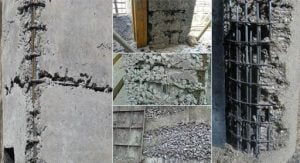Table of Contents
Honeycombing in concrete is a defect due to which cavities and hollow pockets are formed and coarse aggregates become prominently visible in the concrete structure.
It is caused due to the incomplete filling of the concrete against the formwork.
Honeycombing is also caused due to the use of concrete that is too stiff or by not vibrating concrete sufficiently after it has been poured.
The honeycombed surface looks rough, with voids and gaps between concrete and reinforcement.

Fig: Honeycombing in Concrete Structures
Honeycomb is a significant problem that reduces the strength of concrete and makes the reinforcement vulnerable.
Honeycombs are usually visible to the naked eye and are detected after removing shuttering or formwork.
Those honeycombs that are not visible to the naked eye and which are inside the mass of concrete are detected with the help of advanced techniques like ultrasonic testing.
1. Causes of Honeycombing in Concrete
a. Insufficient fine material in the mix, perhaps due to incorrect aggregate grading or poor mixing.
b. Improper workability of concrete, i.e., using stiff concrete, which is hard to place.
c. The improper compaction of concrete.
d. Placement of concrete from the height: When we pour concrete from a certain height, the aggregate and mortar separate, causing honeycombing.
e. Typical spots: Proper care should be taken when placing concrete in places like beam-to-beam or beam-to-column joints. As a result of the lapping of one or more layers of reinforcements makes the concrete hard to penetrate through them.
f. Presence of big coarse aggregates in a high amount: Using the bigger size of aggregates in concrete makes the smaller particles difficult to penetrate through them. This results in honeycombing.
g. Movement of formwork before drying of concrete.
h. Concrete already set before placing.
i. Formwork used is not waterproof or watertight.
j. Improper water-cement ratio.
k. Less reinforcement spacing.
( Field Tip: If there is this type of defect on concrete, don’t attempt to hide this with cement paste. Applying cement plaster will not rectify the matter.)
2. Effects of Honeycombing in Concrete
a. Reduction in the strength & bearing capacity of the structure.
b. Decrease in the durability ( or lifespan) of the structure.
c. Rusting and corrosion of rebars.
d. Bad aesthetics.
e. Allows water and air into the concrete.
3. Prevention of Honeycombing in Concrete
a. Well-graded aggregates should be used.
b. Use waterproof and watertight formworks.
c. Proper compaction should be done to prevent over-compaction or low compaction.
d. Use concrete having good workability and also prepared according to the proper mix design.
e. Cohesive concrete mixture should be used. (Tip: If you can prepare a “ball” out of the fresh concrete, you have a cohesive concrete mix.)
f. Concrete fall should be kept minimum. (Tip: The height of concrete fall should not exceed 1m as far as possible.)
g. Maintaining proper water-cement ratio.
h. Prevent the movement of formwork before drying concrete.
i. Proper spacing between reinforcements should be provided for adequately filling the concrete against the formwork.
Important Questions
1. Types of Honeycombs Ans: There are 3 types of honeycombs: a. Small Honeycombs – Depth upto 25mm b. Medium Honeycombs – Depth over 25 mm, but reinforcement is not exposed. c. Large Honeycombs – Depth more than 25 mm, and reinforcement is exposed.
2. Why over-compaction is not preferred? Ans: Because it results in segregation, denser material like aggregate settles to the bottom while lighter material like cement paste moves towards the top.
|
Read Also: Curing of Concrete

